684–871 army202 airforce10 navy personnelTotal 896–1083 690 Dates 28 May 1982 – 29 May 1982 | 45–55 killed98 army wounded and at least 14 air force personnel wounded.961 captured 18 killed64 wounded Result British victory | |
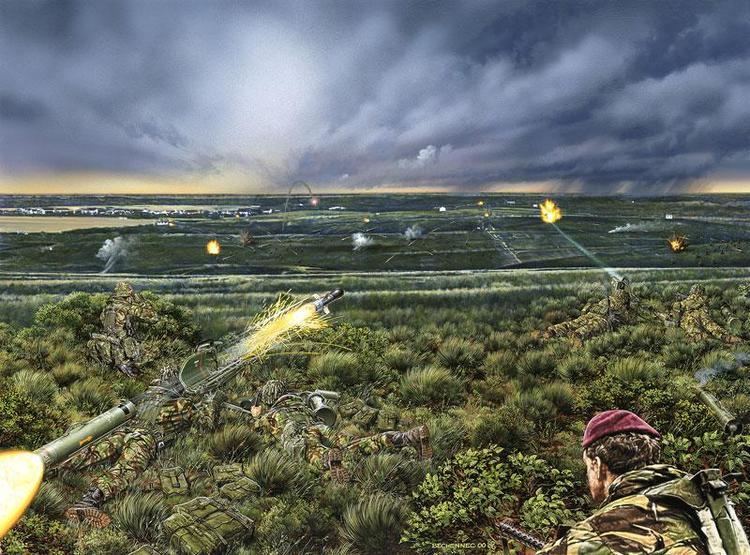 | ||
Similar Falklands War, Battle of Mount Longdon, 1982 invasion of the Falkla, Battle of Mount Tumbledown, Battle of Wireless Ridge | ||
Battle of goose green anniversary 29 05 12
The Battle of Goose Green (28–29 May 1982) was an engagement between British and Argentine forces during the Falklands War. Goose Green and its neighbouring settlement Darwin on East Falkland lie on Choiseul Sound on the east side of the island's central isthmus. They are about 13 miles (21 km) south of the site where the major British amphibious landings took place in San Carlos Water (Operation Sutton) on the night of 21/22 May 1982.
Contents
- Battle of goose green anniversary 29 05 12
- Times and nomenclature
- Terrain and conditions
- Reasons for the attack
- Argentinian defences
- British assault force
- Burntside House
- Darwin Hill
- Attack on the airfield
- Situation at last light on 28 May
- Surrender
- Prisoners and casualties
- Commanders
- Order of battle
- BBC incident
- Argentine military trials of 2009
- References
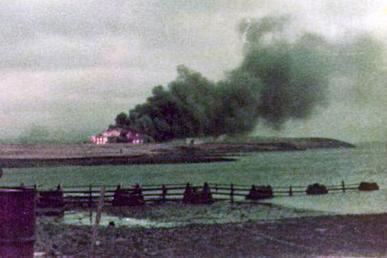
Times and nomenclature
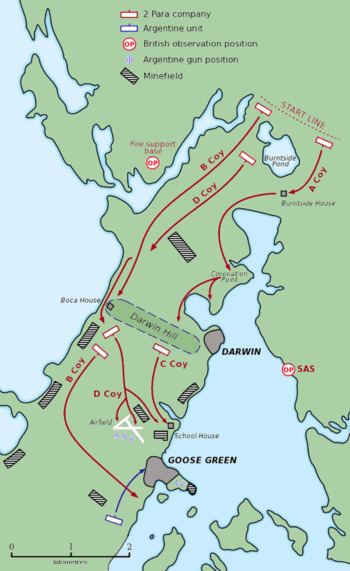
British forces worked on UTC (Zulu) time and many reports and sources quote the timing of events based on Zulu time. All times stated in this page are reflected as local, Falkland Island time (UTC−3), the same as Argentine time. On the day of the battle, sunrise was at 08:39 and sunset at 16:58. To avoid confusion between similar company designations, Argentine companies are referred to in the form "Company A" while British forces are referred to as "A Company."
Terrain and conditions
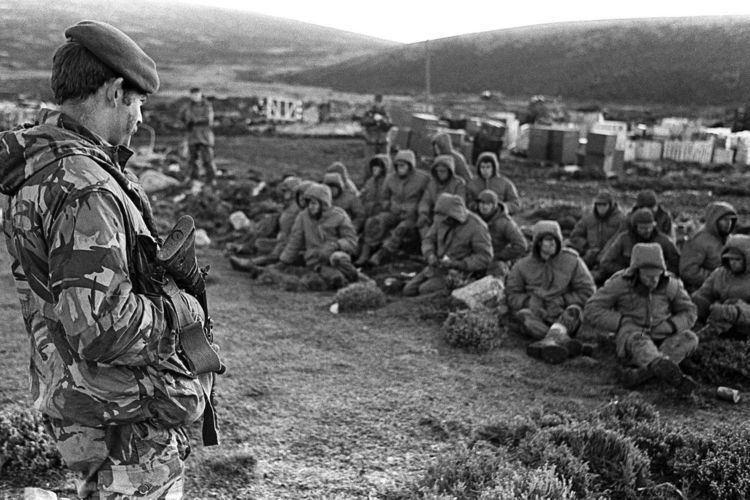
Goose Green and Darwin are on a narrow isthmus connecting Lafonia to Wickham Heights, which together form the large eastern island of the Falkland Islands. The terrain is rolling and treeless and is covered with grass outcrops, areas of thick gorse and peat bogs making effective camouflage and concealment extremely difficult. From May to August, the southern hemisphere winter, the ground is sodden and frequently covered with brackish water, causing movement to be slow and exhausting, especially at night. The isthmus has two settlements, both on the eastern coastal edge with Darwin settlement to the north and Goose Green to the south. The islands have a cold, damp climate and light, drizzly rains occur two out of every three days with continuous winds. Periods of rain, snow, fog, and sun change rapidly, and sunshine is extremely limited, leaving few opportunities for troops to warm up and dry out.
Reasons for the attack
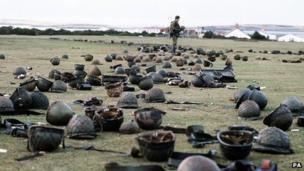
The bulk of the Argentine forces were in positions around Port Stanley about 50 miles (80 km) to the east of San Carlos. The Argentine positions at Goose Green and Darwin were well defended by a force of combined units equipped with artillery, mortars, 35 mm cannon and machine guns. British intelligence indicated that the Argentine force presented limited offensive capabilities and did not pose a major threat to the landing area at San Carlos. Consequently, Goose Green seemed to have no strategic military value for the British in their campaign to recapture the islands and initial plans for land operations had called for Goose Green to be isolated and bypassed.
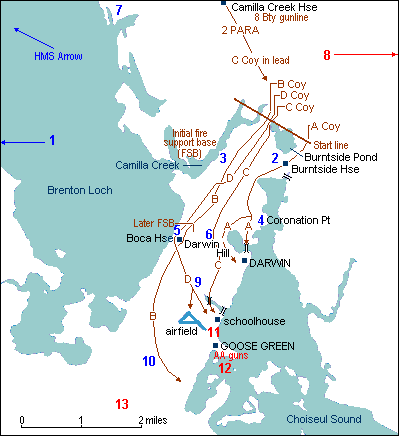
After the British landings at San Carlos on 21 May and while the bridgehead was being consolidated, no offensive ground operations had been conducted and activities were limited to digging fortified positions, patrolling and waiting; during this time Argentine air attacks caused significant loss of and damage to British ships in the area around the landing grounds. These attacks, and the lack of movement of the landed forces out of the San Carlos area, led to a feeling among senior commanders and politicians in the UK that the momentum of the campaign was being lost. As a result, British Joint Headquarters in the UK came under increasing pressure from the British government for an early ground offensive of political and propaganda value. There were also fears that the United Nations Security Council would vote for a cease-fire, maintaining current positions. If the Darwin-Goose Green isthmus could be taken prior to such a decision, British forces would control access to the entire Lafonia and thus a significant portion of East Falkland. On 25 May Brigadier Julian Thompson, ground forces commander, commanding 3 Commando Brigade, was again ordered to mount an attack on Argentine positions around Goose Green and Darwin.
Argentinian defences
The defending Argentine forces, known as Task Force Mercedes, consisted of two companies of Lieutenant-Colonel Ítalo Piaggi's 12th Infantry Regiment (IR12)—his third company (Company B) was still deployed on Mount Kent as "Combat Team Solari" and was only to re-join the battalion after the first days of fighting. The task force, in 1982, also contained a company of the ranger-type 25th Infantry Regiment (IR25). Air defence was provided by a battery of six 20 mm Rheinmetalls manned by air force personnel, and two radar-guided Oerlikon 35 mm anti-aircraft guns from the 601st Anti-Aircraft Battalion, that would be employed in a ground support role in the last stages of the fighting. There was also one battery of three OTO Melara Mod 56 105 mm pack howitzers from the 4th Airborne Artillery Regiment. Pucarás based at Stanley, armed with rockets and napalm, provided close air support. Total forces under Piaggi's commanded numbered 1,083 men.
Piaggi's orders required him to provide a reserve battle group (Task Force Mercedes) in support of other forces deployed to the west of Stanley; to occupy and defend the Darwin isthmus; and to defend Military Air Base Condor located at Goose Green. He assumed an all-round defence posture with Company A IR12 providing the key to his defence, they being deployed along a gorse hedge running across the Darwin isthmus from Darwin Hill to Boca House. Piaggi deployed his Recce Platoon as an advance screen forward of Company A IR12 towards Coronation Ridge while Company C IR12 were deployed south of Goose Green to cover the approaches from Lafonia. To replace his Company B left on Mount Kent, he created a composite company from headquarters and other staff and deployed them in Goose Green. First Lieutenant Carlos Daniel Esteban's "ranger" Company C IR25 provided a mobile reserve and were billeted at the school-house in Goose Green. Elements were also deployed to Darwin settlement, Salinas Beach and Boca House and the air force security cadets together with the anti-aircraft elements were charged with protecting the airfield. Minefields had been laid in areas deemed tactically important (refer to map 2) to provide further defence against attack.
On paper Piaggi had a full regiment, but it consisted of units from three separate regiments from two different brigades, none of whom had ever worked together. IR12 consisted mostly of conscripts from the northern, sub-tropical province of Corrientes, while the IR25 Company was considered an elite formation and well-led. At the start of the battle, the Argentinian forces had about the same number of effective combatants as the British paratroopers. Some elements were well-trained and displayed a high degree of morale and motivation (Company C IR25 and 25 Signal company); one of their officers remarking that: "...we are going to defend something that is ours." Other companies were less well motivated, with the 12th Regiment chaplain, Santiago Mora writing:
"The conscripts of 25th Infantry wanted to fight and cover themselves in glory. The conscripts of 12th Infantry Regiment fought because they were told to do so. This did not make them any less brave. On the whole, they remained admirably calm."
The Argentine positions were well-selected, and officers were well-briefed. In the weeks before the battle British air strikes, poor logistic support and inclement conditions had contributed to the reduction of overall Argentine morale, but it remained strong among the officers, NCOs and conscripts of the 25th Regiment company and 4th Airborne Artillery battery.
On 4 May three Royal Navy Sea Harriers operating from HMS Hermes attacked the airfield and installations at Goose Green. During the operation, a Sea Harrier was shot down by Argentine 35mm anti-aircraft fire, killing its pilot. As part of the diversionary raids to cover the British landings in the San Carlos area on 21 May, which involved naval shelling and air attacks, 'D' Squadron of the SAS put in a major raid to simulate a battalion-sized attack on the Argentine troops dug in on Darwin Ridge. Argentine forces had also spotted 2 Para reconnaissance parties in the days prior to the attack. Throughout 27 May, Royal Air Force Harriers were active over Goose Green. One of them, responding to a call for help from 2 Para, was lost to 35mm fire while attacking Darwin Ridge. The Harrier attacks, the sighting of the reconnaissance elements as well as the BBC announcing that the 2nd Battalion of the Parachute Regiment were poised and ready to assault Darwin and Goose Green the day before the assault alerted the Argentine garrison to the impending attack.
British assault force
Thompson ordered 2nd Battalion of the Parachute Regiment (2 Para) to prepare for and execute the operation as they were the unit closest to Goose Green in the San Carlos defensive perimeter. He ordered Lieutenant-Colonel Herbert 'H' Jones, officer commanding 2 Para, to "carry out a raid on Goose Green isthmus and capture the settlements before withdrawing in a reserve for the main thrust to the north." The "capture" component appealed more to Jones than the "raid" component, although Thompson later acknowledged that he had assigned insufficient forces to rapidly execute the "capture" part of the orders.
Two Para consisted of three rifle companies, one patrol company, one support company and an HQ company. Thompson had assigned three 105 mm artillery pieces with 960 shells from 29 Commando Regiment, Royal Artillery; one MILAN anti-tank missile platoon and Scout helicopters as support elements. In addition, close air support was available from three Royal Air Force Harriers, and naval gunfire support was to be provided by HMS Arrow in the hours of darkness.
SAS reconnaissance had reported that the Darwin – Goose Green area was occupied by one Argentine company. Brigade intelligence reported that enemy forces consisted of three infantry companies (two from IR12 and one from IR25), one platoon from IR8 plus a possible amphibious platoon together with artillery and helicopter support. Jones was not too perturbed by the conflicting intelligence reports and, incorrectly, tended to believe the SAS reports, on the assumption that they were actually "on the spot" and were able to provide more accurate information than the brigade intelligence staff. Based on this intelligence and the orders from Thompson, Jones planned the operation to be conducted in six phases, as a complicated night-day, silent-noisy attack. C Company was to secure the start line and then A Company was to launch the attack from the start line on the left (Darwin) side of the isthmus. B Company would launch their attack from the start line directly after A Company had initiated contact and would advance on the right (Boca House) side of the isthmus. Once A and B companies had secured their initial objectives, D Company would then advance from the start line between A and B companies and were to "go firm" on having exploited their objective. This would be followed by C Company, who were required to pass through D Company and neutralise any Argentine reserves. C Company would then advance again and clear the Goose Green airfield after which the settlements of Darwin and Goose Green would be secured by A and D companies respectively.
As most of the helicopter airlift capability had been lost with the sinking of Atlantic Conveyor, 2 Para were required to march the 13 miles (21 km) from San Carlos to the forming-up place at Camilla Creek House. C Company and the commando engineers moved out from there at 22:00 on 27 May to clear the route to the start line for the other companies. A fire base (consisting of air and naval fire controllers, mortars and snipers) was established by Support Company west of Camilla Creek, and they were in position by 02:00 on the morning of 28 May. The three guns from 8 Battery, their crew and ammunition had been flown in to Camilla Creek House by 20 Sea King helicopter sorties after last light on the evening of 27 May. The attack, to be initiated by A Company, was scheduled to start at 03:00, but because of delays in registering the support fire from HMS Arrow, only commenced at 03:35.
Burntside House
At 03:35 HMS Arrow opened fire (she was to fire a total of 22 star-shell (illumination) and 135 rounds of 4.5" HE shells in a 90-minute bombardment), signalling the start of the attack. In the ensuing night battle about twelve Argentines were killed. The platoon under Sub-Lieutenant Gustavo Adolfo Malacalza fought a delaying action against the British paratroopers, blooding themselves on Burntside Hill before taking up combat positions again on Darwin Ridge.
Major Philip Neame's D Company was temporarily halted by the Coronation Ridge position. Two of his men, 24-year-old Lance-Corporal Gary Bingley and 19-year-old Private Barry Grayling darted out from under cover to charge the enemy machine gun nest that was holding up the advance. Both were hit 10 metres (11 yd) from the machine gun, but shot two of the crew before collapsing. Bingley "got hit in the head and I got hit in the hip," Grayling recalled in an interview published in 2007. "Unfortunately, he didn't make it." Bingley was posthumously awarded the Military Medal and Grayling was decorated with the Queen's Gallantry Medal. With the enemy machine gun out of action, the paras were able to clear the Argentine platoon position, at the cost of three dead.
Then 2 Para moved on to the south via Darwin Parks. The Argentines made a determined stand along Darwin Ridge. As A and B companies moved south from Coronation Ridge they were raked by fire from a couple of concealed Argentine FN MAG machine guns. An Argentine senior NCO, Company Sergeant-Major Juan Carlos Cohelo, is credited with rallying the IR12's A Company remnants falling back from Darwin Parks, and was later awarded the Medal of Valour in Combat. He was seriously wounded later in the day.
The first British assault was broken up by fire from Sub-Lieutenant Ernesto Orlando Peluffo's IR12 platoon after the platoon sergeant, Buenaventura Jumilla, warned that the British were approaching. Corporal David Abols later said that an Argentine sniper was mainly responsible for holding up A Company and with shooting several paras in the morning fighting. Nevertheless, the paras called on the Argentines to surrender. The death of Lieutenant-Colonel Jones was attributed to a sniper identified as Corporal Osvaldo Faustino Olmos, who was interviewed by the British newspaper Daily Express in 1996.Olmos, of IR25 had refused to leave his foxhole and his section fired at Jones and the five paratroopers who accompanied him as he moved forward.
At this juncture of the battle, 2nd Para's advance had become stuck. A Company was in the gorse line at the bottom of Darwin Hill, and against the entrenched Argentines who were looking down the hill at them. As it was now daylight, Jones led an unsuccessful charge up a small gully resulting in the death of the adjutant, Captain Wood, A Company's second-in-command Captain Dent, and Corporal Hardman.
Shortly thereafter Jones was seen to run west along the base of Darwin Ridge to a small re-entrant, followed by his bodyguard. He checked his Sterling submachine gun, then ran up the hill towards an Argentine trench. He was seen to be hit once, then fell, got up and was hit again from the side. He fell metres short of the trench, hit in the back and the groin, and died within minutes.
As Jones lay dying, his men radioed for urgent casualty evacuation. However, the British Scout helicopter sent to evacuate Jones was shot down by an Argentine FMA IA 58 Pucara ground attack aircraft. The pilot, Lieutenant Richard Nunn RM was killed and posthumously received the DFC, and the aircrewman, Sergeant Belcher RM was badly wounded in both legs. Corporal José Luis Ríos, of the 12th Regiment's Reconnaissance Platoon who in the opinion of historian Hugh Bicheno had killed Jones, was later fatally wounded manning a machine-gun in his trench by Abols, firing a 66 mm rocket.
Jones was posthumously awarded the Victoria Cross.
Darwin Hill
By then it was 10:30 and Major Dair Farrar-Hockley's A Company made a third attempt, but this petered out. Eventually the British company, hampered by the morning fog as they advanced up the slope of Darwin Ridge, were driven back to the gulley by the fire of 1st Platoon of IR25's C Company, under the command of 2nd Lieutenant Roberto Estévez.
During this action Estévez directed Argentine 105 mm artillery and 120 mm mortar fire that posthumously earned him the Argentine Nation to the Heroic Valour in Combat Cross (CHVC). Two Para's mortar crews fired 1,000 rounds to keep the enemy at bay, and helped stop the Argentines getting a proper aim at the paras.
It was almost noon before the British advance resumed. A Company soon cleared the eastern end of the Argentine position and opened the way forward. There had been two battles going on in the Darwin hillocks – one around Darwin Hill looking down on Darwin Bay, and an equally fierce one in front of Boca Hill, also known as Boca House Ruins. Sub-Lieutenant Guillermo Ricardo Aliaga's 3rd Platoon of RI 8's C Company held Boca Hill. The position of Boca Hill was taken after heavy fighting by Major John Crosland's B Company with support from the MILAN anti-tank platoon. Sub-lieutenants Aliaga and Peluffo were gravely wounded in the fighting. Crosland was the most experienced British officer and, as the events of the day unfolded, it was later said that Crosland's cool and calm leadership of his soldiers on the battlefield turned the Boca House section of the front line.
About the time of the victory at the Boca Hill position, A Company overcame the Argentine defenders on Darwin Hill, finally taking the position that had resisted for nearly six hours, with many Argentine and British casualties. Majors Farrar-Hockley and Crosland each won the Military Cross for their efforts. Corporal David Abols was awarded a Distinguished Conduct Medal for his daring charges which turned the Darwin Hill battle.
Attack on the airfield
After the victory on Darwin Ridge, C and D Companies began to make their way to the small airfield as well as Darwin School, which was east of the airfield, while B Company made their way south of Goose Green Settlement. A Company remained on Darwin Hill. C Company took heavy losses when they became the target of intense direct fire from 35 mm anti-aircraft guns, causing 20 per cent casualties. Private Mark Holman-Smith, a signaller in the company headquarters, was killed by anti-aircraft guns while trying to recover a heavy machine gun from wounded Private Steve Russell.
Lieutenant James Barry's No. 12 Platoon, D company, saw some fierce action at the airfield. They were ambushed, by another platoon of the 25th Regiment but one of his men shot dead two of the attackers, and then reported the events to Major Neame. The platoon sergeant charged the attacking enemy with his machine gun, killing four of them. Private Graham Carter won the Military Medal by rallying No. 12 Platoon and leading it forward at bayonet point to take the airfield.
The IR25 platoon defending the airfield fled into the Darwin-Goose Green track and was able to escape. Sergeant Sergio Ismael Garcia of IR25 single-handedly covered the withdrawal of his platoon during the British counterattack. He was posthumously awarded the Argentine Nation to the Valour in Combat Medal. Four Paras of D Company and approximately a dozen Argentines were killed in these engagements. Among the British dead were 29-year-old Lieutenant Barry and two NCOs, Lance-Corporal Smith and Corporal Sullivan, who were killed after Barry's attempt to convince Sub Lieutenant Juan José Gómez Centurión to surrender, had been rebuffed. C Company had not lost a single man in the Darwin School fighting, but Private Steve Dixon, from D Company, died when a splinter from a 35 mm anti-aircraft shell struck him in the chest. The Argentine 35mm anti-aircraft guns under the command of Second Lieutenant Claudio Oscar Braghini reduced the schoolhouse to rubble after sergeants Mario Abel Tarditti and Roberto Amado Fernandez reported to him that sniper fire was coming from there.
At around this time three Harriers made an attack on the Argentine 35mm gun positions; the army radar-guided guns were unable to respond effectively because a piece of mortar shrapnel had earlier struck the generator to the guns and fire-control radar. This greatly lifted morale among the British paras and helped convince Piaggi of the futility of continued resistance. Although it was not known at the time, the Harriers came close to being shot down in their bomb run after being misidentified as enemy aircraft by Lieutenant-Commander Nigel Ward and Flight Lieutenant Ian Mortimer of 801 Squadron.
Situation at last light on 28 May
By last light, the situation for 2 Para was critical. A Company was still on Darwin Hill north of the gorse hedge, B Company had penetrated much further south and had swung in a wide arc from the western shore of the isthmus eastwards towards Goose Green. They were isolated and under fire from an Argentinian platoon and unable to receive mutual support from the other companies. To worsen their predicament Argentine helicopters—a Puma, a Chinook and six Hueys—landed southwest of their position just after last light, bringing in the remaining Company B of IR12 (Combat Team Solari) from Mount Kent. B company managed to bring in artillery fire on these new reinforcements, forcing them to disperse towards the Goose Green settlement, while some re-embarked and left with the departing helicopters. For C Company, the attack had also fizzled out after the skirmish at the school-house with the company commander injured, no radio contact and the platoons scattered with up to 1,200m between them. The C Company second-in-command was also unaccounted for. D Company had regrouped just before last light, and they were deployed to the west of the dairy; exhausted, hungry, low on ammunition and without water. Food was redistributed to share one ration-pack between two men for A and C Companies, but B and D Companies could not be reached. At this time a British helicopter casualty evacuation flight took place, successfully extracting C Company casualties on the forward slope of Darwin Hill under fire from Argentine positions.
To Keeble, the situation looked precarious: the settlements had been surrounded but not captured, and his companies were exhausted, cold and low on water, ammunition and food. His concern was that the Company B reinforcements dropped by helicopter would either be used in an early morning counter-attack, or used to stiffen the defences around Goose Green. He had seen the C Company assault stopped in its tracks by the AA fire from the airfield, and had seen the Harrier strikes of earlier that afternoon missing their intended targets. In an order group with the A and C Company commanders, he indicated his preference for calling for an Argentine surrender rather than facing an ongoing battle the following morning. His alternative plan, if the Argentines did not surrender, was to "flatten Goose Green" with all available fire-power and then launch an assault with all forces possible, including reinforcements he had requested from Thompson. On Thompson's orders, J Company of 42 Commando, Royal Marines, the remaining guns of 8 Battery, and additional mortars were helicoptered in to provide the necessary support.
Surrender
Once Thompson and 3 Brigade had agreed to the approach, a message was relayed by CB radio from San Carlos to Mr. Eric Goss, the farm manager in Goose Green – who in turn delivered it to Piaggi. The call explained the details of a planned delegation who would go forward from the British lines to the Argentine positions in Goose Green bearing a message. Piaggi agreed to receive the delegation. Soon after midnight, two Argentine Air Force warrant officer prisoners of war were sent to meet with Piaggi and to hand over the proposed terms of surrender. On receiving the terms, Piaggi concluded "..The battle had turned into a sniping contest. They could sit well out of range of our soldiers' fire and, if they wanted to, raze the settlement. I knew that there was no longer any chance of reinforcements from 6th [Compañía 'Piribebuy'] Regiment's B Company and so I suggested to Wing Commander [Vice Commodore] Wilson Pedrozo that he talk to the British. He agreed reluctantly." The next morning, agreement for an unconditional surrender was reached and Pedrozo held a short parade and those on parade then laid down their weapons. After burning the regimental flag, Piaggi led the troops and officers, carrying their personal belongings, into captivity.
Prisoners and casualties
Between 45 and 55 Argentines were killed (32 from IR12, 13 from Company C 25IR, five killed in the Platoon from IR8, 4 Air Force staff and one Navy servicemen) and about 86 wounded. The claim in various British books that the 8th Regiment lost five killed defending Boca House is disputed, with other sources claiming that Corporal Juan Waudrik (supposedly killed at Boca House) was mortally wounded in late May after the tractor he was riding detonated a mine at Fox Bay, and that Privates Simón Oscar Antieco, Jorge Daniel Ludueña, Sergio Fabián Nosikoski and Eduardo Sosa, the four conscripts reportedly killed fighting alongside Waudrik, were killed in the same locality on West Falkland during a naval bombardment on 9 May. In all, the 8IR lost 5 killed during the Falklands War. The remainder of the Argentine force were taken prisoner. Argentine dead were buried in a cemetery to the north of Darwin, and the wounded were evacuated to hospital ships via the medical post in San Carlos. Prisoners were used to clear the battlefield; in an incident involving the moving of artillery ammunition, four IR12 conscripts were involved in a huge explosion that caused two fatalities and two seriously wounded. After clearing the area and assisting with the burying of the dead, the prisoners were marched to and interned in San Carlos. The British lost 18 killed (16 Paras, one Royal Marine pilot and one commando sapper) and 64 wounded. The seriously wounded were evacuated to the hospital ship Uganda.
Commanders
Lieutenant-Colonel Ítalo Ángel Piaggi surrendered his forces in Goose Green on the Argentinian National Army Day (29 May). After the war he was forced to resign from the army, and faced ongoing trials questioning his competence at Goose Green. In 1986 he wrote a book titled Ganso Verde, in which he strongly defended his decisions during the war and criticised the lack of logistical support from Stanley. In his book he said that Task Force Mercedes had plenty of 7.62mm rifle ammunition left, but had run out of 81mm mortar rounds, and there were only 394 shells left for the 105mm artillery guns. On 24 February 1992, after a long fight in both civil and military courts, Piaggi had his retired military rank and pay reinstated as a full colonel. He died in July 2012.
Lieutenant-Colonel Herbert 'H' Jones was buried at Ajax Bay on 30 May; after the war his body was exhumed and transferred to the British cemetery in San Carlos. He was posthumously awarded the Victoria Cross.
Major Chris Keeble, who took over command of 2 Para when Jones was killed, was awarded the DSO for his actions at Goose Green. Keeble's leadership at Goose Green was one of the key factors which led to the British victory, in that his flexible style of command and the autonomy he afforded to his company commanders was much more successful than the rigid control and adherence to plan exercised by Jones. Despite sentiment among the soldiers of 2 Para for him to remain in command, he was superseded by Lieutenant-Colonel David Robert Chaundler, who was flown in from Britain to take command of the battalion.
Order of battle
All order of battle data from Fitz-Gibbon (2002), unless otherwise stated
BBC incident
During the planning of the assault of both Darwin and Goose Green, the Battalion Headquarters were listening in to the BBC World Service. The newsreader announced that the 2nd Battalion of the Parachute Regiment were poised and ready to assault Darwin and Goose Green, causing great confusion with the commanding officers of the battalion. Lieutenant Colonel Jones became furious with the level of incompetence and told BBC representative Robert Fox he was going to sue the BBC, Whitehall and the War Cabinet.
Argentine military trials of 2009
In the years after the battle, Argentine army officers and NCOs were accused of handing out brutal field punishment to their troops at Goose Green (and other locations during the war). In 2009, Argentine authorities in Comodoro Rivadavia ratified a decision made by authorities in Río Grande, Tierra del Fuego. announcing their intention to charge 70 officers and NCOs with inhumane treatment of conscript soldiers during the war. There were claims, however, that false testimonies were used as evidence in accusing the Argentine officers and NCOs of abandonment, and Pablo Vassel who has made the denouncements, had to step down from his post as president of Human Rights Department of Corrientes province. Other veterans are sceptical about the veracity of the accusations with Colonel José Martiniano Duarte, an ex-601 Commando Company officer in the Falklands, saying that it has become fashionable for ex-conscripts to now accuse their superiors of abandonment. Since the 2009 announcement was made, no one in the military or among the retired officers and NCOs has been charged, causing Vassel in April 2014 to comment:
For over two years we've been waiting for a final say on behalf of the courts ... There are some types of crimes that no state should allow to go unpunished, no matter how much time has passed, such as the crimes of the dictatorship. Last year Germany sentenced a 98-year-old corporal for his role in the concentration camps in one of the Eastern European countries occupied by Nazi Germany. It didn't take into account his age or rank.
